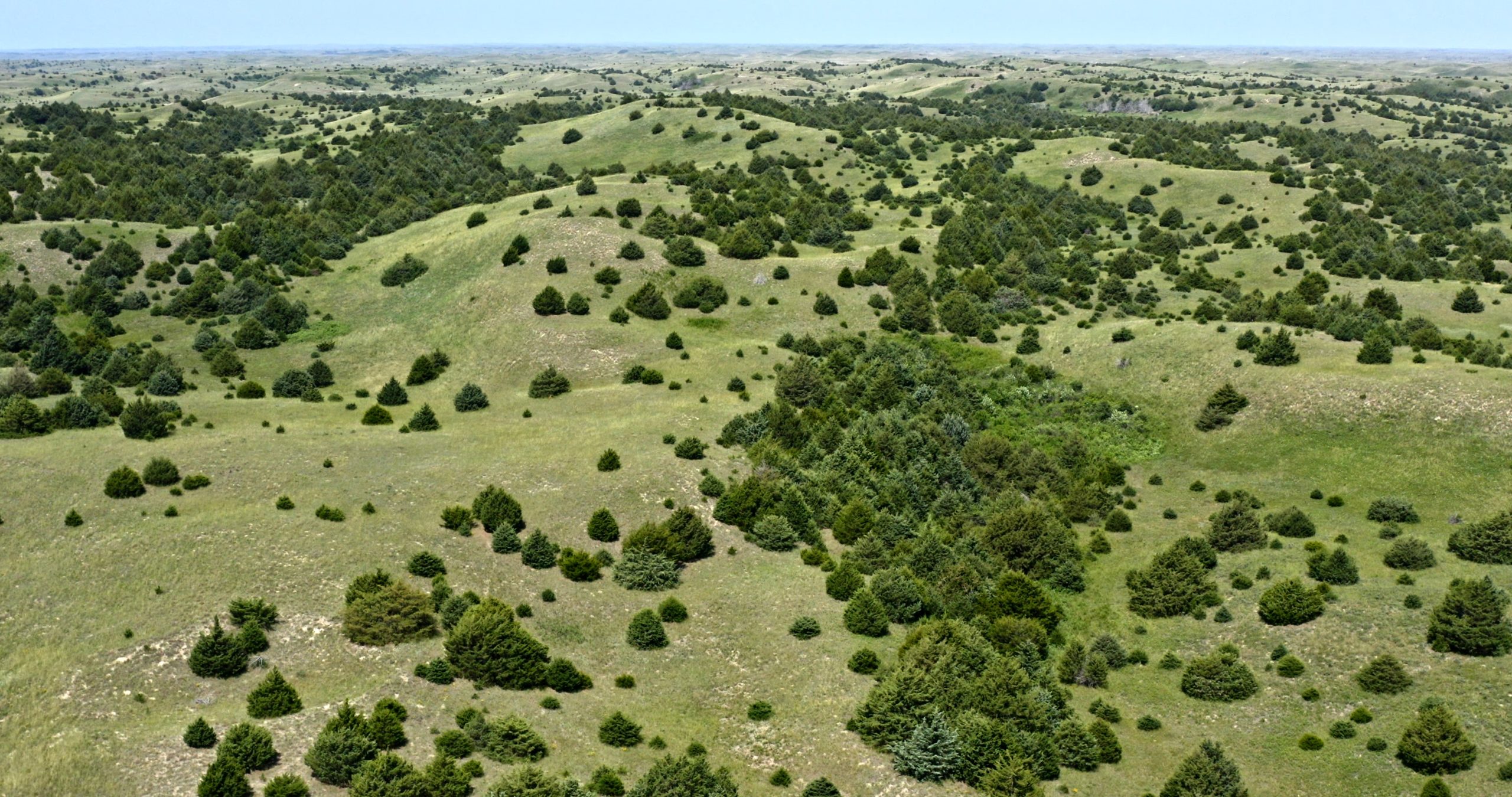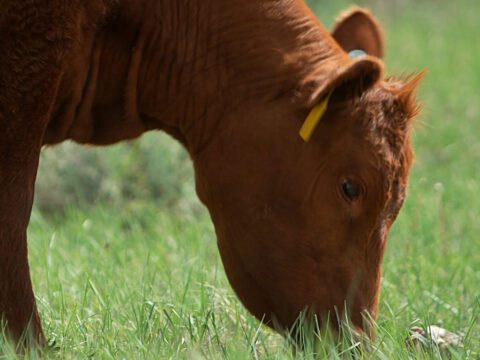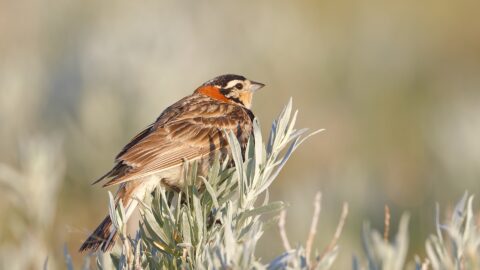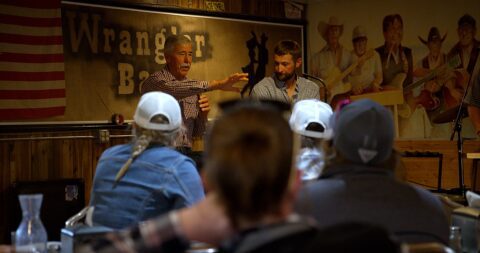“Reconsidering Cedar”
The Threat to Nebraska’s Sandhills
Managing the spread of the Eastern Redcedar, a beloved tree brought to Nebraska by homesteaders, that is now menacing one of the world’s most intact grassland regions.

There is no other threat I can measure in the Sandhills that displaces production and wildlife habitat as much as woody encroachment. I can connect this to every citizen that lives in the Great Plains.
Dr. Dirac Twidwell, University of Nebraska-Lincoln
There’s just thousands of berries and some of these females are just absolutely loaded. And if you look down at the bottom, I mean, it’s just covered with seeds.
It’s so fun to watch him clear these cedar trees. It’s one of my favorite things – watching cedar trees die.
You just can’t imagine when this is cleaned off from here – how amazing it’s going to be.
My great uncle was kind of like our grandfather. He planted a lot of trees, and I remember that he said his mom loved trees. And it was really hard for her when she came down to this part of the country, not having trees. She felt really exposed.
I’m guessing most of these were probably planted – twenties and thirties.
This is a pretty breezy day and we’re standing here and it feels really good. And they just function as outdoor barns. I mean, we value what trees he did plant when we calve because they literally save lives during a blizzard and whatnot for our livestock. So they do have value. But we want to contain them to where they’re at. And it’s all the volunteer trees that are taking away our large unfragmented spaces.
You put 100 trees on this hillside right here, and that’s a lot of grass that’s being choked out. It’s a lot of water being used that the grass that’s there can’t utilize. If you have cedar tree coverage in your pasture, that’s 20 to 30% of your pasture, I would say your capacity to run cattle is probably diminished by half.
These rough hills – this is this is the worst of it right here on my place. That is what all of this is going to look like in ten years.
And I bet ten years ago that they were …
They were little.
Yeah.
I didn’t see them as a problem then. I didn’t realize what a huge problem they were going to become. It seems that they grow exponentially like they’re they’re just blowing up. You’ll have nothing If you do nothing. You’re going to end up with absolutely nothing. The trees are just going to take over.
A lot of you saw this recent story that came out that the Nebraska Sandhills ranks as the most intact true prairie in the world. Seeing horizons of grasslands is increasingly rare. And so there’s a big push globally, but also here of making sure that we try and conserve those last grasslands and not taking them for granted.
Everywhere blue is dominated by grassland. Everywhere red is dominated by woody plants. This is a depiction of our biome. We’re tracking how is our biome changing? And in 20 years we’re talking about massive levels of biome collapse.
The front lines are now – right there and you can feel it, right around Calamus Lake, Burwell area. You see the edge of the biome. And this is now confirmed. It is your number one threat. There is no other threat I can measure in the Sandhills that displaces production, wildlife habitat, as much as woody encroachment.
When we see biome collapse, we expect biome level consequences. So it doesn’t matter what your individual values are or what you care about. I can connect this to every human and citizen that lives in the Great Plains. Because it’s not just if you want to avoid endangered species or see them thrive. It’s not just about pollinators, plant diversity. We’ve got livestock production, tick disease vectors, water, school funding. What’s the biggest change in the Sandhills? The invasion of Cedar. There are seed sources everywhere now, If we leave seed sources, we always have that risk of encroachment and it does encroach. We’re trying to be prepared and have those solutions that can scale because no region has stopped this from eventually collapsing after woody encroachment significantly increases.
Can I get you a coffee?
Coffee would be wonderful. Thank you. You’re really the trendsetter up here with prescribed burning.
A little bit. Yeah. I looked at what we were doing, because we were cutting trees and we were trying to do our best. And I had a guy clear out this one section. He came three different times in three year increments and kept cutting the small trees. He’d clear cut it every year, and they were just coming back thicker and thicker. I was down in this one valley and I started looking across there and just looked like red carpet of Cedars. I mean, after a while, you’re just mowing trees and so you’re cutting the grass and everything else with it. So the only way we’re going to be able to stop the bleeding is burning.
35 years ago, if somebody would have came and sat at your table at coffee and said, these three cedar trees on top of your hill are going to take over your pastures, would you believe it?
It would have been a little hard to believe.
It would have been hard to believe.
Because, you know, at the time you wanted trees. Oh, yeah, that’d be nice windbreak. But you had no clue that it was going to spread like it is. Because once you get seed stock away from your tree belts, it, you know, it just multiplies fast. What’s really neat about it is our neighbors are really taken after it, and all of them are up for burning, too. And as neighbors getting together and doing this thing, it’s going to be great because we’re getting rid of so much seed stock and we’re going to start conquering this thing in our area. And we have to I mean, otherwise we won’t have pasture. That’s that’s all there is to it.
Fire. It’s such a great tool. It is terrifying. It can cause huge destruction. But so much of what we do on the ranch is dangerous. And so everything has risks. And we’re risking losing our livelihood if we don’t take after these cedar trees.
This pasture was burned just a couple of weeks ago. You can see that the grass is already coming back. It’s really tough to see the ground not covered. And this does look scary to a lot of people. To me, it’s exciting to see because I love seeing all of these dead trees out here. They’re controlled so effectively. And this is a really low cost management tool. In one year, you’ll struggle to find the difference between the burned ground and the unburnt down. It will. It will all look the same.
Nebraska is primarily a prairie state, and there’s very few acres in Nebraska that are forested. Because of the prairie and when people came out here to settle, it was really important to plant some trees, to have some protection. Nebraska promotes planting trees so much that we are the Arbor State. There’s schools in the Sandhills that hand out trees to all of their students on Arbor Day. And one school, right in the heart of the Sandhills, handed out a baby cedar tree. Promoting planting trees is good in some areas, but out here in the prairie. We really need to pay attention to where we are planting trees.
I give Dad a hard time about how long it took him to decide to cut cedars, but he cut cedars before it was a huge issue. It cost $7,000 to cut cedar trees on the whole place. And most of the projects that I get to work with people, that won’t even clear a section. So convincing folks to clear cedar trees before it’s a huge issue is something pretty important.
Nebraska lost 420,000 tons of forage in one year 2019 to cedar trees. And that’s that’s just a phenomenal number , that is phenomenal. And to lose that much in one year, I mean, that kind of puts it into perspective, that’s an eye opener.
Stewardship is a big word. And I don’t know of any other word you could say – to try to take care of it and leave it, leave it better than the way you found it – That’s, that’s kind of my goal.
When we think about protecting land, a lot of times we think about removing people from the land. Out in the Sandhills. It’s pretty sparsely populated to begin with. But these ranchers make their primary livelihood out of being stewards of the land. If they’re a really good steward, they’re a successful rancher.
When we empower ranchers and we help them be successful, we’re helping the Sandhills. By helping them financially when they cleared cedar trees, were helping their whole operation and giving them the ability to take care of the ecosystem and the landscape.
This is actually one of my favorite spots. I love this pasture. I don’t know, probably because we had a really good burn in it . We had a good burn. And this pasture is kind of between a really nice, Prairie Chicken lek and a Sharp-tailed Grouse lek . So it’s really prime nesting habitat in here.
That’s what the Great Plains are – grazers and birds. And that’s the way it’s always been on the Great Plains. You know, they’ve grown up together. That’s what shaped the plains – is grazing and fire. And so all the wildlife that we have, especially the birds, that’s, that’s how they live. It’s part of the, part of the whole system.
End of Transcript
Our partners emphasized that woody encroachment must be treated as a biome-wide threat. We showed in the film how extensively cedar trees have spread over the last 20 years, both across the Great Plains and in the heart of the Sandhills.



